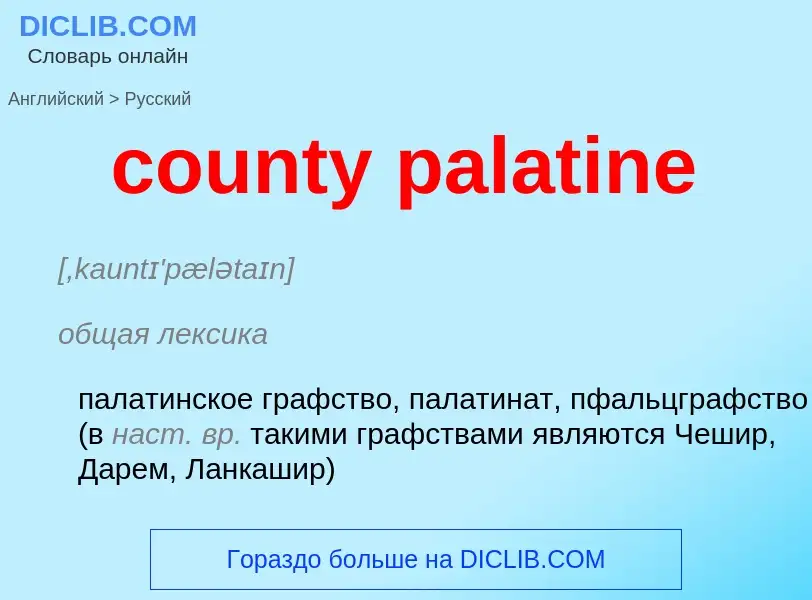Перевод и анализ слов искусственным интеллектом ChatGPT
На этой странице Вы можете получить подробный анализ слова или словосочетания, произведенный с помощью лучшей на сегодняшний день технологии искусственного интеллекта:
- как употребляется слово
- частота употребления
- используется оно чаще в устной или письменной речи
- варианты перевода слова
- примеры употребления (несколько фраз с переводом)
- этимология
Earl Palatine - перевод на русский
[,kauntɪ'pælətaɪn]
общая лексика
палатинское графство, палатинат, пфальцграфство (в наст. вр. такими графствами являются Чешир, Дарем, Ланкашир)
от лат. palatinum - дворец
палатинское графство (графства Чешир, Ланкашир, Дарем)
история
пфальцграфство
палатинат
Определение
Википедия

In England, Wales and Ireland a county palatine or palatinate was an area ruled by a hereditary nobleman enjoying special authority and autonomy from the rest of a kingdom. The name derives from the Latin adjective palātīnus, "relating to the palace", from the noun palātium, "palace". It thus implies the exercise of a quasi-royal prerogative within a county, that is to say, a jurisdiction ruled by an earl, the English equivalent of a count. A duchy palatine is similar but is ruled over by a duke, a nobleman of higher precedence than an earl or count.
The nobleman swore allegiance to the king yet had the power to rule the county largely independently of the king. It should therefore be distinguished from the feudal barony, held from the king, which possessed no such independent authority. Rulers of counties palatine created their own feudal baronies, to be held directly from them in capite, such as the Barony of Halton. County palatine jurisdictions were created in England under the rule of the Norman dynasty. In continental Europe, they have an earlier date.
In general, when a palatine-type autonomy was granted to a lord by the sovereign, it was in a district on the periphery of the kingdom, at a time when the district was at risk from disloyal armed insurgents who could retreat beyond the borders and re-enter. For the English sovereign in Norman times this applied to northern England, Wales and Ireland. As the authority granted was hereditary, some counties palatine legally survived well past the end of the feudal period.


![Boundary]] of the County Palatine of Lancaster within England Boundary]] of the County Palatine of Lancaster within England](https://commons.wikimedia.org/wiki/Special:FilePath/EnglandLancashireTrad.png?width=200)
![Flamines]]. Flamines]].](https://commons.wikimedia.org/wiki/Special:FilePath/Apex (hat).gif?width=200)
